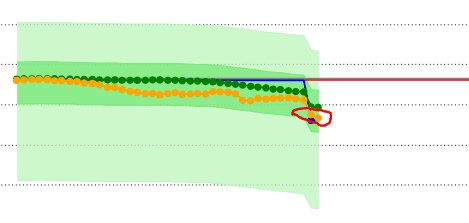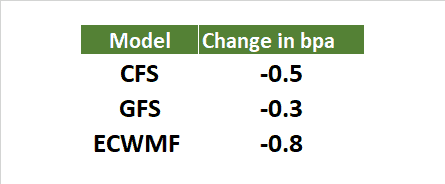The daily corn and soybean futures markets can be impacted by the changes in the weather forecast from one day to the next. Why? Because market participants react to changes in the weather forecast and what those changes imply for corn and soybean yields. But most people are guessing what the impact of the weather forecast is on crops. How are they estimating what the impact of one day’s weather forecast is compared to the next (we don’t know how anyone is doing that other than guessing)? This 24-hour change in the forecast is called the “run to run” change because each time the weather forecast is calculated is considered to have been “run”. So, by comparing one “run” of the weather forecast model to the next, a person is looking at the “run to run” change.
However, any person eyeballing the impact significant “run to run” weather forecast model changes on the corn yield forecast can only be making a very rough estimation. The person interpreting the information must consider time of year, weather conditions year to date, and they must integrate and/or average the information over the corn belt, the soybean belt, and the winter wheat belt to be able to estimate the impact of the change in the forecast. There is an alternate solution that objectively quantifies all this information. You guessed it: CropProphet. CropProphet to objectively calculates the impact of the new model forecast on the corn yield forecast.
The image below shows the June 12, 2019 24 hour weather forecast change for growing degree days for 1 week and 2 weeks ahead. A person interpreting this information would have to understand what the yield differences are between the western portion of the US Midwest in one week in advance and then determine if the impact of the two weeks in advance change to warmer temperatures in western Iowa is significant to corn yield or not.

Likewise, the graphic below shows the week 1 and week 2 24 hour change in the precipitation forecast. Is the two weeks lead time forecast shift in the precipitation significant to corn yield or soybean yield?

It’s a significant challenge to determine what the impact of the forecast change implies for the corn yield forecast. Fortunately, CropProphet can do that for you. The graphic below shows the time progression of CropProphet forecasts over time from our “Year-to-Date” model (in green) and from the ECMWF weather forecast model (in Orange).

Because CropProphet quantifies the impact of the weather forecast information on the corn yield forecast, the impact of the “run to run” change of the weather forecast is simply the day to day change in the yield forecast, highlighted in the red circle. We provide a number of ways to view this information.

The key point is that interpretation of the weather forecast models in terms of the impact on the corn yield forecast or the soybean yield forecast is diffucult. Interpreting the impact of the changes from one weather forecast to another is even harder. Fortunately, CropProphet objectively quantifies that impact of the weather forecasts and it’s changes for you every day of the crop season.